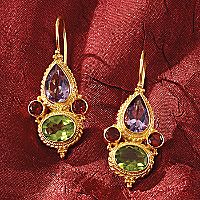Gemstones: Nature s Gift of Beauty and Rarity
By: Ron Peterson
The naturally occurring gemstone is a crystalline form of a mineral. Desirable for their beauty, gemstones are also loved for their rarity and durability. As adornments in jewelry, gemstones can bring enjoyment for generations. While many gems have remained popular for years, some are rare collector stones that have only been discovered recently.
Emeralds

The much loved emerald is admired for its radiant green color. The top quality emeralds are considered even more valuable than diamonds. For centuries, fantastic stories have grown up around this magnificent gem and in some cultures the gemstone held great power. For instance, in South America the Incas and Aztecs considered the emerald a holy gemstone. Indian maharajas believed the green emerald to possess healing and good luck powers. They were so valued in ancient Egyptian society that the pharaohs who ruled between 3,000 to 1,500 B.C. exhausted their plentitude in Cleopatra s Mines. Today s best emeralds hail mostly from Colombia, where there are nearly 150 known emerald deposits, although not all are currently being mined. These stones are known to be especially fine with an emerald green color that is the most highly esteemed in the international emerald trade industry. Emeralds are also harvested in places such as Zambia, Brazil, Madagascar, India and Russia, which have produced some interesting and rare variations and have provided additional sources of emeralds for an eager market.
Ruby
Long associated with power, passion and love, the ruby has long been considered one of the most valuable gemstones in existence. Its brilliance, hardness and gorgeous color are preferred characteristics of a precious stone. In its finest form, a ruby is called a Burmese ruby. This does not necessarily mean the stone s origin is Burma, but that it possesses the rich, full red color with a slight bluish hue, such as those found in the famous deposits of Burma (now called Myanmar). Other ruby deposits are found in Pakistan, Laos, Kashmir, Nepal and Afghanistan. The rubies of India possess many inclusions, but are still suited to be cut as beads or cabochons. East Africa is another site that has recently become a site for rubies. While some very fine rubies were mined from Kenya and Tanzania in the 1960s, they are mostly a rarity. Typically, these stones are considered average in quality. The ruby s most important feature is its color, with transparency being of secondary importance. Inclusions, therefore, do not impair the quality of the stone unless it should decrease the stone s transparency. In fact, these imperfections are known to give a ruby its individuality and help to provide proof of its natural origin.
Sapphire
Earlier civilizations believed that the firmament was actually an immense blue sapphire in which the earth was embedded. It s not hard to believe that theory when one considers all the blue shades the sky and sapphires both contain. Sapphires also come in a variety of other colors such as yellow, pink, orange, and purple. However, blue remains the much favored color. Found in India, Burma, Ceylon, Thailand and Brazil, and Vietnam to name a few, sapphires are cut by skilled craftsmen who respect the stone is that is not only durable, but it also produces various colors and intensities of color, depending on which angle it is viewed. The challenge for the cutter is to bring out the stone to its very best advantage. The most precious blue sapphires came from Kashmir in the 1880s. These stones created a lasting impression on people s idea of a first class sapphire s color. The intense blue with subtle violet undertones does not change with artificial light.
Amethyst
Coveted by royalty for generations, the amethyst has had numerous powers attributed to it by a variety of cultures. It has occupied a prominent position in the ornaments of the Catholic clergy because of its representation of chastity and piety. Therefore, it has served as the stone of bishops and clergy.When heated, the amethyst changes its color. Smoky stones turn shining yellow to brownish red when heated by temperatures of 250 degrees. Meanwhile, stones with high transparency turn yellow or colorless at 400 degrees. Note to amethyst wearers: this tendency to change colors can render an amethyst colorless in daylight so avoid sunbathing while wearing an amethyst. Amethysts are imported from Brazil, Uruguay and Madagascar. However, valuable specimens can be found all over the world. In North America, Lake Superior on the Canadian side is home to Amethyst Harbor. Here, violet quartz is found in generous quantities although it is not considered gemstone quality. At one time, Russia s Empress Catherine the Great enlisted thousands of miners into the Urals to mine for amethyst. While Uruguay produces beautifully rich amethyst of the deepest color, much of it is blemished. It s not surprising then that truly immaculate stones can fetch fairly high prices from those who covet its violet brilliance.
Author Resource:-> Lewis Jewelers is proud to carry the full line of Pandora Jewelry - bracelets, charms and beads are only a part of the collection. Contact Lewis Jewelers, 2000 West Stadium Blvd., Ann Arbor, Michigan, 48103, 877-88-LEWIS or visit http://www.LewisJewelers.com/pandora_bracelets/, http://www.PandoraB
Article From Freebie Articles









No comments:
Post a Comment